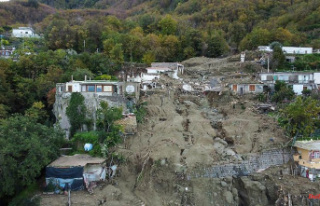With low "Yuki" the new week starts rainy and stormy. At the beginning, the temperatures will remain mild, but by Thursday at the latest, winter will be knocking on the door. Weather expert Björn Alexander reveals when and where the first snow will fall.
At the start of the week, our weather kitchen is still untidy. A band of clouds from the low "Yuki" centered on Iceland has crossed the west of our country, but is only making its way to the middle with difficulty. There are more weather fronts in tow, but a thick bulwark in the east is holding up.
High "Erik" over Eastern Europe is starving the fronts over us and from the middle of the week it will increasingly influence the weather in Germany. Because it brings colder air from east to south-east and a touch of early winter to us. This is supported by a sometimes brisk to stormy wind, which ensures that the perceived temperatures often remain in the frost range.
A real onset of winter at the beginning of the month - as some weather computers have repeatedly predicted in the last few days - has been pushed back further for the time being. The combination of cold air and snow down to the lowlands will therefore not take place until St. Nicholas Day at the earliest. And of course, the longer it takes, the greater the chances of a white Christmas. After all, it would soon be time for snow again at the festival. The last time in Germany was 12 years ago, i.e. in December 2010.
Meanwhile, by the way - from a meteorological point of view - winter begins on December 1st. The calendar start of winter follows a good three weeks later. This year on December 21st. In contrast to the astronomical change of seasons, which can always vary slightly and depends on the position of the sun, the statistical classification of the beginning of the month always has a fixed beginning and end. This means that the seasons are statistically comparable because they are always the same length.
Monday night: rain from the west, dry east
The weather front from low "Yuki" temporarily brings heavy rain in Lower Saxony and Schleswig-Holstein. Another reason is that the clouds from the west are hardly moving eastwards. Accordingly, it remains dry and partly loosened up in the east. Among the larger loosening with lows of 1 to -1 degrees. Otherwise it cools down to 6 to 2 degrees. A sometimes stormy southeast wind is blowing, especially on the coast.
Monday: Mild start to the week
At the beginning of the new weather week it is often gray and in the northwest and directly on the Alps there is occasional light rain or drizzle. Only in the east will it remain completely dry. In addition, it is comparatively mild with 2 degrees in the Ore Mountains and 12 degrees on the Upper Rhine.
Tuesday: It's getting colder
The weather in autumn picks up: it is mostly gray or foggy and cloudy - especially in the west with intermittent rain. And also in the south it is often wet. Snow falls at altitudes above about 1000 meters. The best chances of significant sunny spells are in the east. Maximum values: 2 degrees on the eastern low mountain ranges and up to 10 degrees on the Upper Rhine.
Wednesday: Sun continues to be rare
Again it is cloudy or foggy. But only in the west is there still light rain at times. It is most likely to be friendly or sunny in Saxony and in the Alps. The temperatures reach between 2 and 9 degrees.
Thursday: Winter begins in a gray robe
The sun continues to be cautious. And of course that is still due to the mix of clouds, fog and high fog. A few drops of snow may fall over the middle and a few snowflakes on the peaks of the low mountain ranges at temperatures around 0 degrees. Otherwise, the excitement about the weather is limited. Except maybe that the cool wind makes the 2 to 7 degrees in the lowlands feel colder too.
Friday and weekend: No significant change
Most of the time it stays gray and there is some rain along the middle, which turns into snow and drizzle in the mountains. The best way to spend the day in the Alps is with a few hours of sun. Temperatures: in the mountains from about 800 meters permafrost, otherwise 1 to 6 degrees. On the second weekend in Advent, it often remains foggy and cloudy and dry. Only the mountains in the south get more sun. The whole thing at 0 to 7 degrees with frosty nights in some areas.












